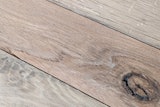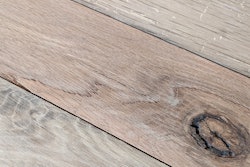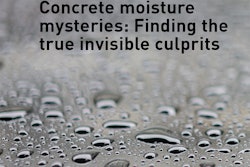
 Along some wall lines, the adhesive had not transferred to the flooring.
Along some wall lines, the adhesive had not transferred to the flooring.
The Homeowner's Issue
The homeowner noticed after move-in her china in the china cabinet made noise as she walked past the cabinet, and her husband noticed the wood floor moved up and down in certain areas. The homeowner recalled paying extra to have the floor glued down with premium flooring adhesive and called the retailer to stop by and look at the floor. The retailer had no answers and contacted the subcontract installers. The installers said they used the trowel recommended by the adhesive manufacturer and had the trowels listed on the flooring invoice. A certified flooring inspector was contacted.
Roy: The Inspector's Observations
The floor was identified as a 3¼-inch solid maple glued down over a concrete subfloor. I checked for looseness of flooring and located it in isolated areas near some of the walls. The wood floor could move up and down about 1/16 to ⅛ inch in various locations. Destructive testing showed there was little to no adhesive transfer to the back of the flooring. The subfloor was within specifications for flatness. I checked with the adhesive manufacturer, and they said the maximum open time for this adhesive is three hours. My conclusion was the installer missed the working time of the adhesive when closing up the floor along the walls. This is a common problem when installers spread more adhesive than they can cover in the recommended time allowance and the adhesive becomes too dry for proper adhesive transfer. This flooring concern is not adhesive/flooring manufacturer-related but rather is installation-related.
Blake: The Attorney's Analysis
This situation shows that attention to all details is important. While the installer used the correct glue and other materials, and the subfloor was within flatness specs, consideration was not given to how long the glue could be exposed before attaching the flooring to the subfloor. In this case, the glue sat too long and dried out, and therefore the flooring did not properly adhere to the subfloor, causing the "up and down" effect the homeowners experienced.
Too often installers operate based on their hands-on experience and do not scrutinize the specifications for the products being used. Had the installer in our example read the directions related to this particular glue, he or she would have learned that the manufacturer required a piece of flooring be lifted and inspected to confirm there was a proper adhesive transfer. Based on the facts presented, the installer is responsible to reinstall the areas of the floor that did not adhere properly.
RELATED: Sticky Questions: Q&As on Essential Adhesive Know-How


































